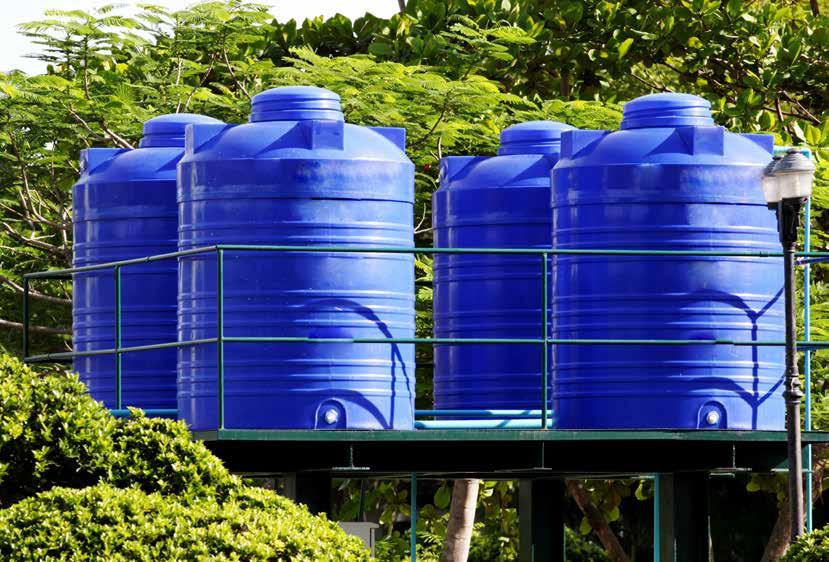
4 minute read
Water Supply
Long-term solutions needed

Advertisement
The Covid-19 pandemic in South Africa precipitated a need for water tanks to be installed across the country to ensure communities have clean water. It has also highlighted the extent to which many communities still do not have adequate access to water and sanitation.
National Treasury approved the use of R306 million from the Department of Human Settlements, Water and Sanitation’s (DHSWS’s) 2019/20 Regional Bulk Infrastructure Grant for the implementation of Covid-19 interventions.
By 20 April, 7 698 water tanks had been installed across the country, and 1 239 water tankers deployed. Since then, thousands more tanks have been rolled out to schools and communities across South Africa. The aim has been to supply communities that are without access to a continuous supply of piped potable water with clean water for handwashing and hygiene in order to stem the spread of the novel coronavirus.
A more permanent solution The widespread roll-out of tanks has drawn attention to the need for more permanent water supply solutions for unserved communities.
Mannie Ramos Jnr, COO, Abeco Tanks, stresses that short-term solutions are not the answer to the systemic water crisis in our communities. The problem is that, although 95% of South Africans now have water supply infrastructure, only 64% have a supply that is both safe and reliable. For
residents of informal settlements, the situation The problem is use of tanks is costly and therefore not sustainable. is even worse. that, although However, he notes that He explains that, at the outset of the pandemic 95% of South while this change was highly beneficial to all in South Africa, the Africans now stakeholders, the revised entire supply of plastic have water supply interventions did not lead tanks in the country was purchased as government infrastructure, to sustainable supplies, as there was no follow-up rushed to provide only 64% have a to rectify the poor informal settlements and communities with water. supply that is both governance issues causing the appalling state of However, these 5 000 ℓ safe and reliable disrepair that existed prior plastic water tanks are to the drought. meant for individual home “The same situation applies use, not for larger communities. He highlights today, in 2020. A very comprehensive follow-up various problems. First, these tanks are too in line with the National Water and Sanitation small for the needs of these communities. They Master Plan’s call to action will be required also require a foundation, and therefore need to turn around the current water services to be implemented in tandem with a stand or crisis that already existed before Covid-19,” concrete slab. says Hazelton.
Speaking in a joint Portfolio Committee and Today, with many more households having Select Committee on Human Settlements, piped water, fixing visible leaks on distribution Water and Sanitation meeting on Covid-19 systems and from fixtures on private property initiatives in April, Minister Lindiwe Sisulu noted also needs to proceed immediately, so that that there had been a lag in the distribution downstream users without water receive of tanks because they needed to be mounted a supply. on platforms. The provision of the platforms He calls for water services authority (WSA) was the role of municipalities, which faced capacity building, community employment challenges in accessing the cement and bricks creation, improved wastewater management, needed to mount and fix the tanks in position reduced leakage from water systems, and the because hardware stores were closed under financial strengthening of WSAs to turn around Level 5 lockdown. the current water services crisis.
As at 20 April, a total of 18 875 tanks had been allocated to be distributed nationally. Of these, Larger tanks a better solution 14 737 tanks had been delivered, but only 7 698 Ramos Jnr points out that larger tanks, which had been installed. can hold up to 50 million litres of water, could
Ramos Jnr points out further challenges: provide a better solution as they need to be queuing poses a risk of spreading the disease filled less frequently than 5 000 ℓ tanks, and and taps will need to be regularly sanitised. therefore reduce the logistics complexity. Tankers will also be required to fill up smallBy installing larger-volume tanks, multiple taps sized tanks around the clock, which can be a can be inserted 1.5 m apart – an option that is logistical nightmare. not available with the 5 000 ℓ plastic tanks. More
Because of the possibility of corruption, the taps will reduce queueing times and allow for DHSWS, together with CoGTA, decided that more effective social distancing, which is key to private companies will not be allowed to fill the preventing the spread of Covid-19. tanks. Instead, the joint parliamentary portfolio Ultimately, Ramos Jnr calls for more spending committee was told that the DHSWS would on water infrastructure such as fabricated eventually buy all the trucks delivering water water reservoirs and the connection of larger and allow the previous businesses to drive tanks to a main water supply as a longer-term government-owned trucks. measure until water infrastructure is piped in.
Professional water services consultant “Water tanks should be viewed as a Derek Hazelton also expresses concern over longer-term strategy to bank water and interventions largely being limited to water make it available to communities until water tanks. He draws on his experiences as the infrastructure projects are implemented. If one coordinator: Water Supply Task Force for the thinks about how people save money in a bank National Consultative Forum on Drought in for when they need it, in the same way water 1992/93. During the 1992/93 drought, efforts tanks should be viewed as ‘banks’ for water quickly moved from tankering to refurbishing that can be used during times of emergency or old boreholes and drilling new ones, as the water shortages,” he concludes.










